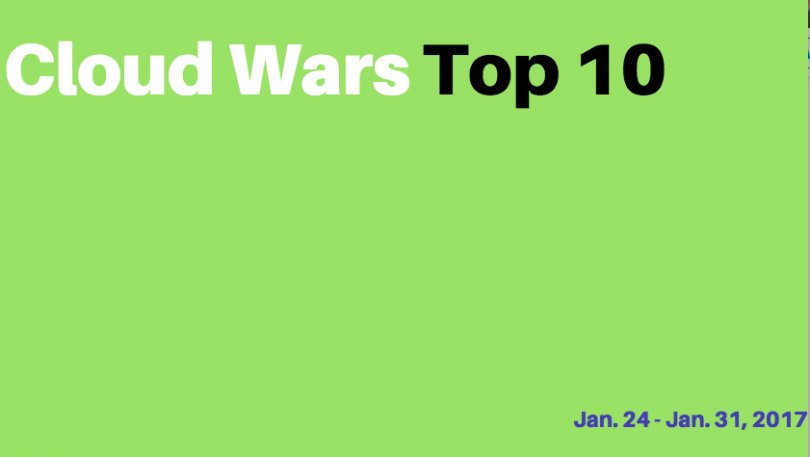 aNewDomain — SAP this week revealed it has defied an immutable law in the enterprise-software business. Its 2016 cloud revenue leapt 31 percent from the year before; its traditional on-premise licensing business repeated mere single-digit growth.
aNewDomain — SAP this week revealed it has defied an immutable law in the enterprise-software business. Its 2016 cloud revenue leapt 31 percent from the year before; its traditional on-premise licensing business repeated mere single-digit growth.
<
div class=”prose”>
Customers are rapidly adopting SAP’s ultra-modern S/4 HANA suite of applications. That’s a terrific opportunity for SAP to claw into the enormous installed bases of apps from Oracle, Salesforce.com, Workday and others, and it may not come again.
Some 5,400 SAP customers have already acquired S/4 HANA, reports SAP. And that more than 10 percent of those are live.
On the earning call with analysts this week, SAP CEO Bill McDermott wasted no time talking up the potential here. “In one beautiful intuitive user experience, a CEO can bring together live data from every corner of her business,” he said, “from finance and logistics to customer and workforce engagement.”

Of course, the dynamics of our consumer-driven, always-on digital economy require that businesses master exactly that type of end-to-end awareness and insight. No wonder SAP says it has only begun to exploit the opportunity here.
“Please keep in mind (that) ,5,400 S/4 HANA customers means more than 85 percent of our installed base are in the pipeline,” McDermott said, adding that they “are still to be migrated, not to mention the thousands and thousands of customers around the world that will switch from their current provider.
“This, ladies and gentlemen, is a once-in-a-generation business opportunity, and we intend to grab it,” he told analysts.
SAP’s numbers and McDermott’s interpretation of them have to be particularly galling to Oracle CEO Mark Hurd.
On Oracle earnings calls for each of the past several quarters he has made a habit of saying that his sales teams “never see” SAP in the marketplace. Then he goes on to denigrate SAP with phrases along the lines of “they’re just not a factor” or “wfe just don’t run into them out in the market.”
Customers, analysts and the media should be asking Hurd some hard follow-up questions.
If SAP is such a non-factor and is offering you no competition, as Oracle claims, then exactly where did the 31 percent cloud-revenue growth that SAP is claiming come from?
Also, If SAP’s such a non-factor in the marketplace, as Oracle claims, and if you still feel they deserve your scorn and derision, then why is SAP’s traditional licensing business growing while Oracle’s is declining?
And finally, if SAP has no answer for Oracle’s modern cloud apps, as Oracle says, then how in the world did SAP land the big wins for S/4HANA at Apple, Nike, and Coca-Cola?
Apple, Nike and Coca-Cola are helping SAP HANA surge …
In McDermott’s comments to analysts this week, he talked about how SAP’s ” digital boardroom changes the game for business leaders,” adding: In one beautiful intuitive user experience, a CEO can bring together live data from every corner of her business from finance and logistics to customer and workforce engagement.”
That’s a good example, he said, of what SAP means when it talks about its fully integrated portfolio.
“S/4HANA delivers the modern, digital core system to connect the supply chain to the demand chain,” McDermott continued. “And as a result, Apple has once again extended their long-term partnership with SAP to further leverage SAP innovations such as HANA and S/4HANA. Very exciting, Apple — thank you.
“With the S/4HANA platform, Nike will run a live business, and plans to transform how they bring merchandise to market worldwide. Coca-Cola, ThyssenKrupp AG and Ameco Beijing selected S/4HANA in the fourth quarter.
“And 2017 will continue to reveal the acceleration of S/4HANA in every single deployment model, public cloud, private cloud or a customer’s own data center.”
Clearly, these excellent Q4 results from SAP require me to re-evaluate SAP’s position in the Cloud Wars Top 10 ranking, where the company currently sits in the No. 7 spot. I can promise you that when next week’s rankings come out, SAP will be closer to the top.
Later in the call, McDermott cited two other exciting new growth categories for 2017 and beyond: the white-hot “machine learning” greenfield sector and—finally!—the availability in the cloud of SAP’s hugely popular ERP applications. (I suspect Oracle’s Hurd will pooh-pooh these as more silly irrelevance from SAP, but let’s just wait and see if the buying public endorses or rejects Hurd’s perspective.)
Here’s McDermott on the potential of machine learning: “From invoice matching to predictive recruiting to intelligent sales forecasting, SAP Machine Learning applications will drive significant value for our customers,” he said.
McDermott then took the very rare approach of telling the analysts to refactor their models to account for the massive revenue growth he expects SAP to generate from machine learning (highlights mine): “We need to start turning up the advertising and the marketing on what we’re already doing for machine learning, whether it is recruiting, employee approvals, payment processing, sales-discounting approval or call-center management.
We already have our machine-learning solutions in place and we’re rolling them out across industries. It will be a huge source of growth and probably not factored in your models.”
And as big as that machine-learning opportunity could be, my guess is it will be dwarfed by SAP’s other ready-for-prime-time applications rollout: ERP in the cloud. SAP’s head of product development and strategy, Bernd Leukert, one customer was able to get up and running on the SAP’s cloud ERP in just seven weeks.
“While the beginning of the cloud was clearly driven by individual line-of-business solutions, we now see that it’s time for ERP in the cloud,” Leukert said. “And for us at SAP, it’s great that we have anticipated that move early, while we can play both choices.”
Leukert added that demand for the SaaS version of SAP ERP “already started very strong in Q4” and that “one customer went live in just seven weeks from after the very first conversation we had with them, which is the beauty of the cloud.
“So, this ease of consumption for our entire ERP in the cloud is paying off, and we have ambitious goals for 2017,” Leukert added.
Ambitious goals indeed, but they seem to be grounded in the reality of business customers realizing the enormous value, flexibility, and speed they stand to gain by aggressively adopting the cloud model.
And that, after all, is the entire objective behind this Cloud Wars series—to help illuminate which cloud vendors are truly delivering that type of value to customers, and which ones are blowing hot air.
If you’re interested in getting more detail on the earnings-call presentation from SAP executives and their ensuing Q&A with analysts, SeekingAlpha.com offers a full transcript, as do a variety of other sources—I mention SeekingAlpha because I referred to it in a few places to supplement my own transcription of the call.
Next week in Cloud Wars, I’ll have an overview of Salesforce for you, which sits at No. 2 in our Cloud Wars Top 10 ranking this week. Stay tuned.
For aNewDomain, I’m Bob Evans.













